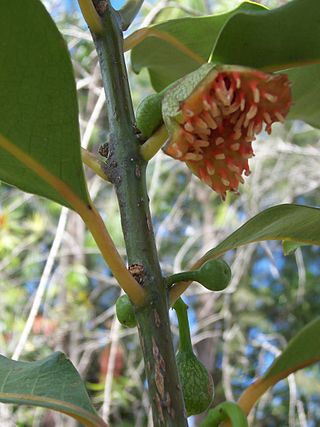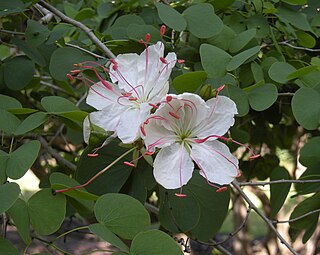
The Ericaceae are a family of flowering plants, commonly known as the heath or heather family, found most commonly in acidic and infertile growing conditions. The family is large, with c. 4250 known species spread across 124 genera, making it the 14th most species-rich family of flowering plants. The many well known and economically important members of the Ericaceae include the cranberry, blueberry, huckleberry, rhododendron, and various common heaths and heathers.

Fabales is an order of flowering plants included in the rosid group of the eudicots in the Angiosperm Phylogeny Group II classification system. In the APG II circumscription, this order includes the families Fabaceae or legumes, Quillajaceae, Polygalaceae or milkworts, and Surianaceae. Under the Cronquist system and some other plant classification systems, the order Fabales contains only the family Fabaceae. In the classification system of Dahlgren the Fabales were in the superorder Fabiflorae with three families corresponding to the subfamilies of Fabaceae in APG II. The other families treated in the Fabales by the APG II classification were placed in separate orders by Cronquist, the Polygalaceae within its own order, the Polygalales, and the Quillajaceae and Surianaceae within the Rosales.

The Bromeliaceae are a family of monocot flowering plants of about 80 genera and 3700 known species, native mainly to the tropical Americas, with several species found in the American subtropics and one in tropical west Africa, Pitcairnia feliciana.
In biological classification, a subfamily is an auxiliary (intermediate) taxonomic rank, next below family but more inclusive than genus. Standard nomenclature rules end botanical subfamily names with "-oideae", and zoological subfamily names with "-inae".

The Araliaceae are a family of flowering plants composed of about 43 genera and around 1500 species consisting of primarily woody plants and some herbaceous plants commonly called the ginseng family. The morphology of Araliaceae varies widely, but it is predominantly distinguishable based on its woody habit, tropical distribution, and the presence of simple umbels.

Iridaceae is a family of plants in order Asparagales, taking its name from the irises. It has a nearly global distribution, with 69 accepted genera with a total of c. 2500 species. It includes a number of economically important cultivated plants, such as species of Freesia, Gladiolus, and Crocus, as well as the crop saffron.

Lythraceae is a family of flowering plants, including 32 genera, with about 620 species of herbs, shrubs, and trees. The larger genera include Cuphea, Lagerstroemia (56), Nesaea (50), Rotala (45), and Lythrum (35). It also includes the pomegranate and the water caltrop. Lythraceae has a worldwide distribution, with most species in the tropics, but ranging into temperate climate regions as well.

Colchicaceae is a family of flowering plants that includes 15 genera with a total of about 285 known species according to Christenhusz and Byng in 2016.

Dipterocarpaceae is a family of 16 genera and about 695 known species of mainly tropical lowland rainforest trees. The family name, from the type genus Dipterocarpus, is derived from Greek and refers to the two-winged fruit. The largest genera are Shorea, Hopea, Dipterocarpus, and Vatica. Many are large forest-emergent species, typically reaching heights of 40–70 m, some even over 80 m, with the tallest known living specimen 93.0 m tall. The species of this family are of major importance in the timber trade. Their distribution is pantropical, from northern South America to Africa, the Seychelles, India, Indochina, Indonesia, Malaysia and Philippines. The greatest diversity of Dipterocarpaceae occurs in Borneo. Some species are now endangered as a result of overcutting, extensive illegal logging, and habitat conversion. They provide valuable woods, aromatic essential oils, balsam, and resins, and are a source for plywood.

Asphodelaceae is a family of flowering plants in the order Asparagales. Such a family has been recognized by most taxonomists, but the circumscription has varied widely. In its current circumscription in the APG IV system, it includes about 40 genera and 900 known species. The type genus is Asphodelus.

The Monimiaceae is a family of flowering plants in the magnoliid order Laurales. It is closely related to the families Hernandiaceae and Lauraceae. It consists of shrubs, small trees, and a few lianas of the tropics and subtropics, mostly in the southern hemisphere. The largest center of diversity is New Guinea, with about 75 species. Lesser centres of diversity are Madagascar, Australia, and the neotropics. Africa has one species, Xymalos monospora, as does Southern Chile. Several species are distributed through Malesia and the southwest Pacific.

Linaceae is a family of flowering plants. The family is cosmopolitan, and includes about 250 species in 14 genera, classified into two subfamilies: the Linoideae and Hugonioideae. Leaves of the Linaceae are always simple; arrangement varies from alternate to opposite or whorled. The hermaphroditic, actinomorphic flowers are pentameric or, very rarely, tetrameric.

Asparagaceae, known as the asparagus family, is a family of flowering plants, placed in the order Asparagales of the monocots. The family name is based on the edible garden asparagus, Asparagus officinalis. This family includes both common garden plants as well as common houseplants. The garden plants include asparagus, yucca, bluebell, and hosta, and the houseplants include snake plant, corn cane, spider plant, and plumosus fern.

Calceolariaceae is a family of flowering plants in the order Lamiales that has been recently segregated from Scrophulariaceae. The family includes three genera, Calceolaria, Porodittia, and Jovellana, but analysis suggests that the monotypic Porodittia should be placed within Calceolaria. Recent molecular phylogenies that included Calceolaria have shown not only that this genus does not belong in Scrophulariaceae but also that it is the sister clade to the majority of the other families of the Lamiales. Morphological and chemical characters also support the separation of Calceolariaceae from Scrophulariaceae and other Lamiales. Some recent studies have supported a sister-group relationship between Calceolariaceae and Gesneriaceae. Given this close relationship, some authors opt to merge this family into Gesneriaceae as subfamily Calceolarioideae

The subfamily Detarioideae is one of the subdivisions of the plant family Fabaceae (legumes). This subfamily includes many tropical trees, some of which are used for timber or have ecological importance. The subfamily consists of 84 genera, most of which are native to Africa and Asia. Pride of Burma and tamarind are two of the most notable species in Detarioideae. It has the following clade-based definition:
The most inclusive crown clade containing Goniorrhachis marginataTaub. and Aphanocalyx cynometroidesOliv., but not Cercis canadensisL., Duparquetia orchidaceaBaill., or Bobgunnia fistuloides(Harms) J. H. Kirkbr. & Wiersema.
Bussea is a genus of flowering plants in the legume family, Fabaceae. It includes seven species of trees and occasionally shrubs native to sub-Saharan Africa, ranging from Guinea to Ghana in West Africa, from Gabon and Angola to Tanzania and Mozambique in central Africa, and to Madagascar. Habitats include seasonally-dry tropical forests and thickets, moist semi-deciduous forests, and evergreen rain forest.

Plagiogyria is a genus of ferns, the only genus in family Plagiogyriaceae in the Pteridophyte Phylogeny Group classification of 2016. Alternatively, the family may be treated as the subfamily Plagiogyrioideae of a very broadly defined family Cyatheaceae, the placement used for the genus in Plants of the World Online as of November 2019.

Cercidoideae is a subfamily in the pea family, Fabaceae. Well-known members include Cercis (redbuds), including species widely cultivated as ornamental trees in the United States and Europe, Bauhinia, widely cultivated as an ornamental tree in tropical Asia, and Tylosema, a semi-woody genus of Africa. The subfamily occupies a basal position within the Fabaceae and is supported as monophyletic in many molecular phylogenies. At the 6th International Legume Conference, the Legume Phylogeny Working Group proposed elevating the tribe Cercidae to the level of subfamily within the Leguminosae (Fabaceae). The consensus agreed to the change, which was fully implemented in 2017. It has the following clade-based definition:
The most inclusive crown clade containing Cercis canadensisL. and Bauhinia divaricataL. but not Poeppigia proceraC.Presl, Duparquetia orchidaceaBaill., or Bobgunnia fistuloides(Harms) J.H.Kirkbr. & Wiersema.

Lysiphyllum is a genus of flowering plants in the legume family, Fabaceae. It includes nine species of trees, semi-scandent shrubs, and lianas which range from India through Myanmar and Thailand to Peninsular Malaysia, Borneo, the Philippines, Java, the Lesser Sunda Islands, New Guinea, the Bismarck Archipelago, and Australia. Typical habitats include seasonally-dry tropical forest and woodland, vine thickets, Brigalow and Gidgee scrubland, floodplains, alluvial flats, tidal forest, mangroves, river and stream banks, and occasionally dunes and coral islets. They can grow on diverse soils including calcareous, granitic, and basaltic.

The subfamily Dialioideae is one of the subdivisions of the plant family Fabaceae (legumes). This subfamily includes many tropical trees and shrubs. The subfamily consists of 17 genera, which are widespread throughout the tropics. It has the following clade-based definition:
The most inclusive crown clade containing Poeppigia proceraC.Presland Dialium guianense(Aubl.) Sandwith, but not Cercis canadensisL., Duparquetia orchidaceaBaill., or Bobgunnia fistuloides(Harms) J. H. Kirkbr. & Wiersema


















